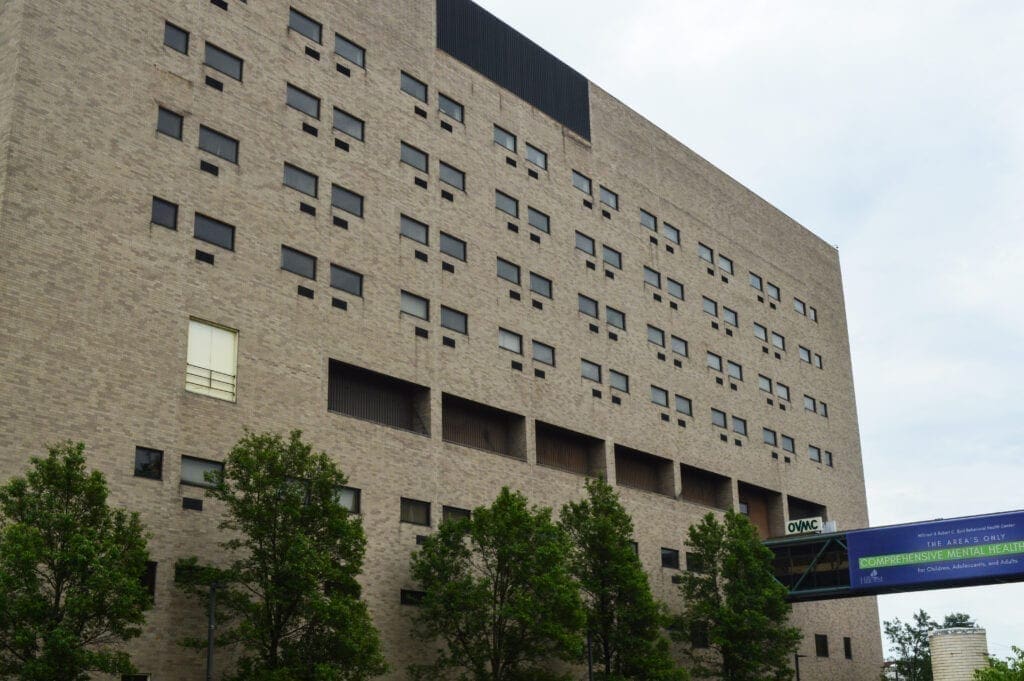
The man who reopened East Ohio Regional Hospital two years ago had his attorneys call the City of Wheeling because he was pretty darn serious about reopening Hillcrest.
Dr. John Johnson, a psychiatrist by trade, is the founder and CEO of Access Ohio, a company that operates hospitals, drug treatment centers, and primary care facilities in Ohio. He’s also a real estate developer, and it is Johnson who purchased the former Wheeling-Pitt building in 2012 to transform the 12 floors into residential loft apartments.
A deal between the good doctor and the City never came to fruition, and once the Covid testing center was closed by the now defunct Roxby Labs, the complex fell silent for the second time in as many years.
“I know I hoped for another healthcare provider to just come in and make a hospital work again but now I know that wasn’t ever going to happen,” said Ward 2 Councilman Ben Seidler. “How that campus works is just crazy to me. The buildings are all connected, but they don’t have separate heating and cooling systems and the infrastructure all would need to be updated.
“The agreement with WVU Medicine is the best thing that could have happened without a doubt,” he insisted. “The City was paying thousands of dollars every month to keep the buildings in shape, but in the winter it was more like $80,000 per month. Thankfully, we don’t have to worry about that anymore.”
It was Kurt Zende’s job for nearly two years to recruit new tenants to fill as many areas of the campus as possible, and he was allowed to dream as big as he wanted to dream.
“When you have that much space to fill, you think about how you can attract as many people as possible,” he explained before his departure for the Wheeling Chamber of Commerce in January 2022. “And with downtown residential being popular, it was easy to imagine that campus being filled with retail on the bottom levels with residential filling the floors above.
“But that’s where a great idea like that one dies because the cost has to come into play,” he said. “It sounds perfect but the age of the buildings and the plumbing and electrical all has to be considered, and with that property, it would all have to be replaced. There is no way I could find a developer to do that when there are more efficient alternatives out there. The historical tax credits wouldn’t even have made it worth it.”

Count the Bricks
Wheeling City Manager Bob Herron is uncertain how the campus will come crumbling down.
“Even though the contract has not been put out there for bid by WVU Medicine, I’d imagine they will start on one end of the campus and continue from there,” he speculated. “It’s going to take some time, that’s for sure, because not only does it have to be taken apart, but all of it has to be hauled away, too, and that might be the biggest part of that job.”
The former Ohio Valley Medical Center was, over a century or so, constructed into the hillside between 20th and 22nd streets in Center Wheeling, and one of the renderings released by WVU Medicine of the new regional cancer center displays a large parking lot that extends from Chapline Street to the top of the property near where W.Va. Route 2 runs north and south.
The new facility, according to the press release distributed by the soon-to-be new property owner, will be a 95,000-square-foot, five-floor structure where 150 employees will report to work. WVU Medicine already operates the Mary Babb Randolph Cancer Center and the Betty Puskar Breast Care Center in Morgantown, the Cancer Institute facilities in several other Mountain State cities.
But first, brick by brick, the removal.
“What the city and the county are involved with are the asbestos abatement and the demolition, and we’ve identified that project as a $7 million project. Of that amount of money, the City of Wheeling is committed to $2 million, the Ohio County Commission is committed to $7 million, and WVU Medicine has committed $3 million,” explained Herron. “As a backstop and contingency because of the unknown, the City of Wheeling has proposed a Section 108 Loan. It is a loan to the City, but a grant to the project.
“Because Wheeling is an entitlement city under CDBG/HUDD regulations, we are eligible to borrow up to three years of your annual entitlement. So, we went for two years at $2.2 million,” he said. “Those funds will be used for either for the demolition or for the cancer center, depending on how it all works out as far as costs are concerned. The loan is automatically paid back through the City’s annual entitlement.”
Until WVU Medicine puts out the bid, reviews the proposals, and appoints a winning contractor, Herron will not know the final figures involved with the total scope of the transformation.
“As we’ve prepared for the costs the City will be responsible for, we’ve estimated certain parts like the asbestos abatement and the demolition, and so far, our numbers for the asbestos removal came in right around where we thought it would,” Herron said. “Now, I have no idea about the demolition. The allocation the City and the County have for demolition right now is around $3.5 million for our share.
“If you Google some big demolitions that have taken place, you’ll see that it cost $5.2 million for Three Rivers Stadium (in February 2020), Mellon Arena was $3.5 million,” he said. “I think the demolition and the asbestos abatement on the OVMC campus are going to cost every bit of $7 million, but we’ll see.”

